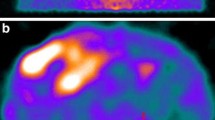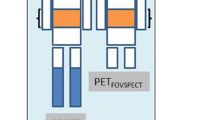Abstract
Purpose
Somatostatin receptor scintigraphy with [111In]-diethylene triamine pentaacetate acid (DTPA)-octreotide is an accurate method for detecting neuroendocrine tumours (NETs) but often does not provide clear anatomical localisation of lesions. The aim of this study was to assess the clinical usefulness of anatomical-functional image fusion.
Materials and methods
Fifty-four patients with known or suspected NET were included in the study. Planar and single-photon-emission computed tomography (SPECT) imaging was performed using a dual-head gamma camera equipped with an integrated X-ray transmission system, and the images were first interpreted alone by two nuclear medicine physicians and then compared with SPECT/CT fusion images together with a radiologist. The improvement provided by SPECT/CT in the interpretation of SPECT data alone and any modification in patientmanagement were recorded.
Results
Fusion images improved SPECT interpretation in 23 cases, providing precise anatomical localisation of increased tracer uptake in 20 cases and disease exclusion in sites of physiological uptake in 5. In 10 patients, SPECT/CT allowed definition of the functional significance of lesions detected by diagnostic CT. SPECT/CT data modified clinical management in 14 cases by changing the diagnostic approach in 8 and the therapeutic modality in 6.
Conclusions
Our study demonstrates that image fusion is clearly superior to SPECT alone, allowing precise localisation of lesions and reducing false-positive results.
Riassunto
Obiettivo
La scintigrafia con 111In-DTPA-octreotide rappresenta un metodo accurato per la diagnosi dei tumori neuroendocrini, ma spesso non fornisce una corretta localizzazione anatomica delle lesioni. Scopo di questo studio è valutare l’utilità clinica della fusione di immagini SPECT-TC.
Materiali e metodi
Sono stati inclusi 54 pazienti con tumore neuroendocrino sospetto o noto. Le immagini planari e SPECT, ottenute utilizzando una gamma-camera a doppia testata con integrato sistema trasmissivo TC, sono state interpretate prima separatamente da due medici nucleari e poi confrontate con immagini di fusione insieme ad un radiologo, per valutare i miglioramenti apportati dalla fusione nell’interpretazione delle immagini SPECT e nella gestione del paziente.
Risultati
Le immagini di fusione hanno migliorato l’interpretazione SPECT in 23 casi, permettendo una precisa localizzazione anatomica dei siti patologici in 20 casi e l’esclusione di malattia in siti di accumulo fisiologico in 5. In 10 pazienti SPECT/TC ha permesso la definizione funzionale di lesioni evidenziate alla TC diagnostica. SPECT/TC ha modificato il management clinico in 14 pazienti, modificando l’approccio diagnostico in 8 e quello terapeutico in 6.
Conclusioni
Il nostro studio dimostra che la fusione di immagini è chiaramente superiore alla sola SPECT, permettendo una precisa localizzazione delle lesioni individuate e riducendo i risultati falsi positivi.
Similar content being viewed by others
References/Bibliografia
Bombardieri E, Maccauro M, de Deckere E et al (2001) Nuclear Medicine imaging of neuroendocrine tumours. Ann Oncol 12 [Suppl 2]:S51–S61
Rubello D, Rufini V, De Carlo E et al (2003) New perspectives in diagnosis and therapy of endocrine gastroenteropancreatic (GEP) tumors with somatostatin analogues. Minerva Endocrinol 28:259–296
Solcia E, Kloeppel G, Sobin LH (2000) Histological typing of endocrine tumors. In: World Health Organization International Histological Classification of Endocrine Tumors, 2nd edn. Springer, Berlin Heidelberg New York, pp 56–68
Rufini V, Calcagni ML, Baum RP (2006) Imaging of neuroendocrine tumors. Semin Nucl Med 36:228–247
Gibril F, Reynolds JC, Doppman JL et al (1996) Somatostatin receptor scintigraphy: its sensitivity compared with that of other imaging methods in detecting primary and metastatic gastrinomas. Ann Intern Med 125:26–34
Lebtahi R, Cadiot G, Sarda L et al (1997) Clinical impact of somatostatin receptor scintigraphy in the management of patients with neuroendocrine gastroenteropancreatic tumors. J Nucl Med 38:853–858
Chiti A, Fanti S, Savelli G et al (1998): Comparison of somatostatin receptor imaging, computer tomography and ultrasound in the clinical management of neuroendocrine gastro-enteropancreatic tumours. Eur J Nucl Med 25:1396–1403
Schillaci O, Danieli R, Manni C et al (2004) Is SPECT/CT with a hybrid camera useful to improve scintigraphic imaging interpretation? Nucl Med Commun 25:705–710
Schillaci O (2005) Hybrid SPECT/CT: a new era for SPECT imaging? Eur J Nucl Med Mol Imaging 32:521–524
Gabriel M, Hausler F, Bale R et al (2005) Image fusion analysis of (99m)Tc-HYNIC-Tyr(3)-octreotide SPECT and diagnostic CT using an immobilisation device with external markers in patients with endocrine tumours. Eur J Nucl Med Mol Imaging 32:1440–1451
Patton JA, Delbeke D, Sandler MP (2000) Image fusion using an integrated, dual-head coincidence camera with X-ray tube-based attenuation maps. J Nucl Med 41:1364–1368
Even-Sapir E, Keidar Z, Sachs J et al (2001) The new technology of combined transmission and emission tomography in evaluation of endocrine neoplasms. J Nucl Med 42:998–1004
Kaltsas GA, Besser GM, Grossman AB (2004) The diagnosis and medical management of advanced neuroendocrine tumors. Endoc Rev 25:458–511
Li S, Beheshti M (2005) The radionuclide molecular imaging and therapy of neuroendocrine tumors. Curr Cancer Drug Targets 5:139–148
Seregni E, Chiti A, Bombardieri E (1998) Radionuclide imaging of neuroendocrine tumours biological basis and diagnostic results. Eur J Nucl Med 25:639–658
Hoyer D, Bell GI, Berelowitz M et al (1995) Classification and nomenclature of somatostatin receptors. Trends Pharmacol Sci 16:86–88
Shi W, Johnston CF, Buchanan KD et al (1998) Localization of neuroendocrine tumors with 111In-DTPA-octreotide scintigraphy (Octreoscan): a comparative study with CT and MR imaging. QJM 91:295–301
Kumbasar B, Kamel IR, Tekes A et al (2004) Imaging of neuroendocrine tumors: accuracy of helical CT versus SRS. Abdom Imaging 29:696–702
Perault C, Schvartz C, Wampach H et al (1997) Thoracic and abdominal SPECT-CT image fusion without external markers in endocrine carcinomas. The Group of Thyroid Tumoral Pathology of Champagne-Ardenne. J Nucl Med 38:1234–1242
Amthauer H, Denecke T, Rohlfing T et al (2005) Value of image fusion using single photon emission computed tomography with integrated low dose computed tomography in comparison with a retrospective voxel-based method in neuroendocrine tumours. Eur Radiol 15:1456–1462
Bocher M, Balan A, Krausz Y et al (2000) Gamma camera-mounted anatomical X-ray tomography: technology, system characteristics and first images. Eur J Nucl Med 27:619–627
Krausz Y, Keidar Z, Kogan I et al (2003) SPECT/CT hybrid imaging with 111In-pentetreotide in assessment of neuroendocrine tumours. Clin Endocrinol (Oxf) 59:565–573
Ozer S, Dobrozemsky G, Kienast O et al (2004) Value of combined XCT/SPECT technology for avoiding false positive planar (123)I-MIBG scintigraphy. Nuklearmedizin 43:164–170
Tharp K, Israel O, Hausmann J et al (2004) Impact of 131I-SPECT/CT images obtained with an integrated system in the follow-up of patients with thyroid carcinoma. Eur J Nucl Med Mol Imaging 31:1435–1442
Hillel PG, van Beek EJ, Taylor C et al (2006) The clinical impact of a combined gamma camera/CT imaging system on somatostatin receptor imaging of neuroendocrine tumours. Clin Radiol 61:579–587
Pfannenberg AC, Eschmann SM, Horger M et al (2003) Benefit of anatomical-functional image fusion in the diagnostic work-up of neuroendocrine neoplasms. Eur J Nucl Med Mol Imaging 30:835–843
Ruf J, Steffen I, Mehl S et al (2007) Influence of attenuation correction by integrated low-dose CT on somatostatin receptor SPECT. Nucl Med Commun 28:782–788
Buchmann I, Henze M, Engelbrecht S et al (2007) Comparison of 68Ga-DOATATOC PET and 111In-DTPAOC (Octreoscan) SPECT in patients with neuroendocrine tumours. Eur J Nucl Med Mol Imaging 34:1617–1626
Gabriel M, Decristoforo C, Kendler D et al (2007) 68Ga-DOTA-Tyr3-octreotide PET in neuroendocrine tumors: comparison with somatostatin receptor scintigraphy and CT. J Nucl Med 48:508–518
Author information
Authors and Affiliations
Corresponding author
Rights and permissions
About this article
Cite this article
Castaldi, P., Rufini, V., Treglia, G. et al. Impact of 111In-DTPA-octreotide SPECT/CT fusion images in the management of neuroendocrine tumours. Radiol med 113, 1056–1067 (2008). https://doi.org/10.1007/s11547-008-0319-9
Received:
Accepted:
Published:
Issue Date:
DOI: https://doi.org/10.1007/s11547-008-0319-9




